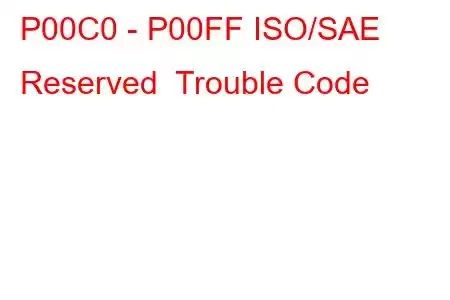What Does ISO/SAE Reserved Mean?
Before attempting to diagnose a code of this type it would benefit us to understand that it is often less about something being broken or defective than about a particular system not meeting certain standards as set forth by a pair of regulatory bodies.
These regulatory bodies are known as the International Standard of Organization (ISO) and the Society of Automotive Engineers (SAE). If the latter abbreviation (SAE) seems familiar it is likely because these three characters are used to clarify that some tools, nuts, bolts, and washers are not metric but standard in thread and/or measure.
Officially titled SAE International, this U.S. based organization was founded in 1905. As you have probably already assumed, the development of standards in the automotive and aerospace industries is it's focus.
Actually called the International Organization for Standardization (IOS), the ISO as it is often referred was not formed until 1947. Like the SAE, which is globally active, the ISO is a voluntary, non-treaty federation of regulatory organizations that is functional in over 100 different countries. Although it was formed to promote international trade in goods and services by instituting a system of uniformity in scientific, intellectual, technological, and economic strategy, it excels in the field of data communication and computer technology. So, what does this have to do with a code being stored (and a service engine soon lamp being illuminated) in your OBD-II automobile?
Since late 1995, automakers have worked closely with the ISO and SAE to institute a practical and unwavering set of mandated guidelines that are cataloged and numbered. These guidelines pertain to the assurance and speed of message delivery in regards to vehicle on-board diagnostic systems and serial data communication. The areas of minimizing conflicting messages, cost efficiency, and electromagnetic field noise suppression are also included in ISO/SAE guidelines.
The CAN bus, the DC bus (a multiplexed communication network), the keyword protocol (allows scanners and other diagnostic devices to communicate with on-board controllers), the local interconnected network (LIN) (responsible for non-critical communication such as entertainment and comfort systems), and the vehicle area network (VAN) are the basic automotive protocols which are subject to the standards set forth by the ISO/SAE.
For the purposes of this diagnostic article, we will only be concerned with the CAN bus. It is a vast network of wires and connectors that allows the PCM and other on-board controllers to communicate instantly and simultaneously with each other. In order to fully understand the importance of the CAN bus, one must realize that there may be as many as seventy on-board controllers present in a single vehicle.
If the powertrain control module (PCM) detects an interface error in one of the many on-board controllers or the controller area network (CAN), which indicates that ISO/SAE guidelines are not being adhered to, a code of this type will be stored and a malfunction indicator lamp may be illuminated.
What Is The Severity Of An ISO/SAE Reserved Trouble Code?
Conditions which contribute to an ISO/SAE code being stored can range from severe to irrelevant. This is one aspect which makes this code potentially frustrating.
Possible Symptoms
Symptoms of an "ISO/SAE Reserved" code may include:
Virtually any drivability symptom; or No symptoms at all Hopefully, other diagnostic trouble codes will be storedPotential Causes For This Code
Wiring or connector damage Defective controller Controller programing error"ISO/SAE Reserved" Diagnostic Information
Unlike many other codes, when diagnosing an ISO/SAE code, the best that you can hope for are other stored codes. The codes and symptoms exhibited (and their
Read: 48


